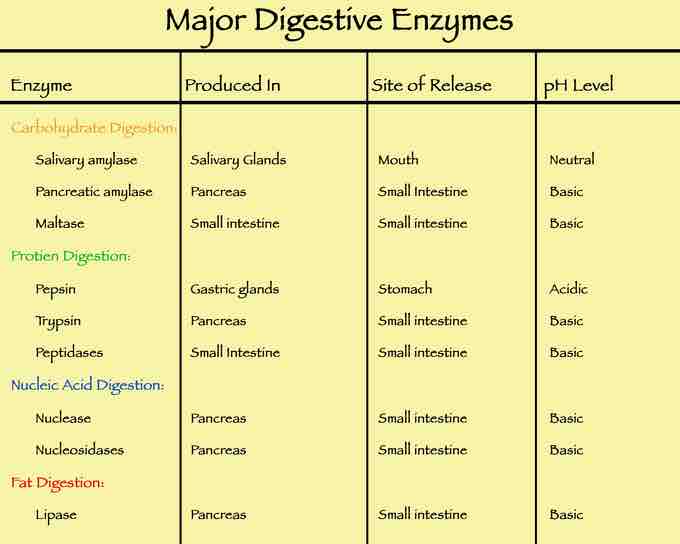The small intestine is where most chemical digestion takes place. Most of the digestive enzymes in the small intestine are secreted by the pancreas and enter the small intestine via the pancreatic duct. These enzymes enter the small intestine in response to the hormone cholecystokinin, which is produced in response to the presence of nutrients. The hormone secretin also causes bicarbonate to be released into the small intestine from the pancreas, neutralizing the potentially harmful acid coming from the stomach.
The three major classes of nutrients that undergo digestion are proteins, lipids (fats), and carbohydrates.
Proteins
Proteins are degraded into small peptides and amino acids before absorption. Chemical breakdown begins in the stomach and continues through the large intestine. Proteolytic enzymes, including trypsin and chymotrypsin, secreted by the pancreas, cleave proteins into smaller peptides. Carboxypeptidase, a pancreatic brush border enzyme, splits one amino acid at a time. Aminopeptidase and dipeptidase free the end amino acid products.
Lipids
Lipids (fats) are degraded into fatty acids and glycerol. Pancreatic lipase breaks down triglycerides into free fatty acids and monoglycerides. Pancreatic lipase works with the help of the salts from bile secreted by the liver and the gall bladder. Bile salts attach to triglycerides, helping emulsify them, which aids access by pancreatic lipase; the lipase is water-soluble, but the fatty triglycerides are hydrophobic, tending to orient toward each other and away from the watery intestinal surroundings. The bile salts act as the "main man" that holds the triglycerides in the watery surroundings until the lipase can break them into the smaller components that are able to enter the villi for absorption.
Carbohydrates
Some carbohydrates are degraded into simple sugars, or monosaccharides (e.g., glucose, galactose) and absorbed by the small intestine. Pancreatic amylase breaks down some carbohydrates (notably starch) into oligosaccharides. Other carbohydrates pass undigested into the large intestine, where they are digested by intestinal bacteria. Brush border enzymes take over from there. The most important brush border enzymes are dextrinase and glucoamylase, which further break down oligosaccharides. Other brush border enzymes are maltase, sucrase, and lactase. Lactase is absent in most adult humans and for them lactose, like most poly-saccharides, is not digested in the small intestine. Some carbohydrates, such as cellulose, are not digested at all, despite being made of multiple glucose units. This is because the cellulose is made out of beta-glucose, making the inter-monosaccharidal bindings different from the ones present in starch, which consists of alpha-glucose. Humans lack the enzyme for splitting the beta-glucose-bonds—reserved for herbivores and bacteria in the large intestine.

Digestive Enzymes
Table of digestive enzymes.